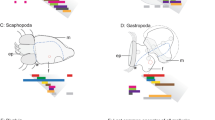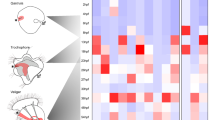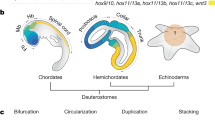Abstract
Cephalopods are a diverse group of highly derived molluscs, including nautiluses, squids, octopuses and cuttlefish. Evolution of the cephalopod body plan from a monoplacophoran-like ancestor1 entailed the origin of several key morphological innovations contributing to their impressive evolutionary success2. Recruitment of regulatory genes3, or even pre-existing regulatory networks4, may be a common genetic mechanism for generating new structures. Hox genes encode a family of transcriptional regulatory proteins with a highly conserved role in axial patterning in bilaterians5; however, examples highlighting the importance of Hox gene recruitment for new developmental functions are also known6,7. Here we examined developmental expression patterns for eight out of nine Hox genes8 in the Hawaiian bobtail squid Euprymna scolopes, by whole-mount in situ hybridization. Our data show that Hox orthologues have been recruited multiple times and in many ways in the origin of new cephalopod structures. The manner in which these genes have been co-opted during cephalopod evolution provides insight to the nature of the molecular mechanisms driving morphological change in the Lophotrochozoa, a clade exhibiting the greatest diversity of body plans in the Metazoa.
This is a preview of subscription content, access via your institution
Access options
Subscribe to this journal
Receive 51 print issues and online access
$199.00 per year
only $3.90 per issue
Buy this article
- Purchase on Springer Link
- Instant access to full article PDF
Prices may be subject to local taxes which are calculated during checkout





Similar content being viewed by others
References
Runnegar, B. & Pojeta, J. J. Molluscan phylogeny: the paleontological viewpoint. Science 186, 311–317 (1974)
House, M. R. in Cephalopods—Present and Past (eds Wiedmann, J. & Kullmann, J.) 1–16 (Schweizerbart'sche Verlagsbuchhandlung, Stuttgart, 1988)
Lowe, C. J. & Wray, G. A. Radical alterations in the roles of homeobox genes during echinoderm evolution. Nature 389, 718–722 (1997)
Keys, D. N. et al. Recruitment of a hedgehog regulatory circuit in butterfly eyespot evolution. Science 283, 532–534 (1999)
Carroll, S. B., Grenier, J. K. & Weatherbee, S. D. From DNA to Diversity: Molecular Genetics and the Evolution of Animal Design (Blackwell Science, Malden, 2001)
Telford, M. J. Evidence for the derivation of the Drosophila fushi tarazu gene from a Hox gene orthologous to lophotrochozoan. Lox5. Curr. Biol. 10, 349–352 (2000)
Godwin, A. R. & Capecchi, M. R. Hoxc13 mutant mice lack external hair. Genes Dev. 12, 11–20 (1998)
Callaerts, P. et al. HOX genes in the sepiolid squid Euprymna scolopes: implications for the evolution of complex body plans. Proc. Natl Acad. Sci. USA 99, 2088–2093 (2002)
Brusca, R. C. & Brusca, G. J. Invertebrates (Massachusetts, Sinauer, Sunderland, 2003)
Boletzky, S. v. in Cephalopods—Present and Past (ed. Wiedmann, J. K., J.)) 167–179 (Schweizerbart'sche Verlagsbuchhandlung, Stuttgart, 1988)
Budelmann, B. U. in The Nervous Systems of Invertebrates: An Evolutionary and Comparative Approach (eds Breidbach, O. & Kutsch, W.) 115–138 (Birkhauser, Basel, 1995)
Hinman, V. F., O'Brien, E. K., Richards, G. & Degnan, B. M. Expression of anterior Hox genes during larval development of the gastropod Haliotis asinina. Evol. Dev. (in the press)
Shigeno, S., Kidokoro, H., Tsuchiya, K., Segawa, S. & Yamamoto, M. Development of the brain in the oegopsid squid, Todarodes pacificus: an atlas up to the hatching stage. Zool. Sci. 18, 527–541 (2001)
Shigeno, S., Tsuchiya, K. & Segawa, S. Embryonic and paralarval development of the central nervous system of the loliginid squid Sepioteuthis lessoniana. J. Comp. Neurol. 437, 449–475 (2001)
Hartmann, B. et al. Pax6 in the sepiolid squid, Euprymna scolopes: evidence for a role in eye, sensory organ and brain development. Mech. Dev. 120, 177–183 (2003)
Boletzky, S. v. McGraw-Hill Yearbook of Science & Technology 73–76 (McGraw-Hill, New York, 1994)
Young, J. Z. The organization of a cephalopod ganglion. Phil. Trans. R. Soc. Lond. B 263, 409–429 (1972)
Boletzky, S. v., Frösch, D. & Mangold, K. Développement de vésicules associées au complexe brachial chez les Céphalopodes. C.R. Acad. Sci. (Paris) D 270, 2182–2184 (1970)
Sundermann, G. Development and hatching state of ectodermal vesicle-organs in the head of Sepia officinalis, Loligo vulgaris, and Loligo forbesi (Cephalopoda, Decabrachia). Zoomorphology 109, 343–352 (1990)
McFall-Ngai, M. & Montgomery, M. The anatomy and morphology of the adult bacterial light organ of Euprymna scolopes Berry (Cephalopoda: Sepiolidae). Biol. Bull. 179, 332–339 (1990)
Nogi, T. & Watanabe, K. Position-specific and non-colinear expression of the planarian posterior (Abdominal-B-like) gene. Dev. Growth Diff. 43, 177–184 (2001)
Kulakova, M. A., Kostyuchenko, R. P., Andreeva, T. F. & Dondua, A. K. The Abdominal-B-like gene expression during larval development of Nereis virens (polychaeta). Mech. Dev. 115, 177–179 (2002)
Zákány, J. & Duboule, D. Hox genes in digit development and evolution. Cell Tissue Res. 296, 19–25 (1998)
Averof, M. & Patel, N. H. Crustacean appendage evolution associated with changes in Hox gene expression. Nature 388, 682–686 (1997)
Burke, A. C., Nelson, C. E., Morgan, B. A. & Tabin, C. Hox genes and the evolution of vertebrate axial morphology. Development 121, 333–346 (1995)
Moshel, S. M., Levine, M. & Collier, J. R. Shell differentiation and engrailed expression in the Ilyanassa embryo. Dev. Genes Evol. 208, 135–141 (1998)
Nederbragt, A. J., van Loon, A. E. & Dictus, W. J. A. G. Expression of Patella vulgata orthologs of engrailed and dpp-BMP2/4 in adjacent domains during molluscan shell development suggests a conserved compartment boundary mechanism. Dev. Biol. 246, 341–355 (2002)
Wanninger, A. & Haszprunar, G. The expression of an engrailed protein during embryonic shell formation in the tusk-shell, Antalis entalis (Mollusca, Scaphopoda). Evol. Dev. 3, 312–321 (2001)
Seaver, E. C., Paulson, D., Irvine, S. Q. & Martindale, M. Q. The spatial and temporal expression of Ch-en, the engrailed gene in the polychaete Chaetopterus, does not support a role in body axis segmentation. Dev. Biol. 236, 195–209 (2001)
Holland, C. H. The nautiloid cephalopods: a strange success. J. Geol. Soc. Lond. 144, 1–15 (1987)
Acknowledgements
We thank D. Paulson for assistance with in situ hybridization protocols; E. Seaver, A. Wikramanayake, L. Nederbragt, D. Matus, K. Pang and L. Kaneshige for critical reading of the manuscript; B. Degnan for sharing unpublished data; S. v. Boletzky for sending us reprints of many cephalopod developmental studies; and M. McFall-Ngai for providing additional embryos. This study was supported by grants from the National Science Foundation to M.Q.M., H.G.d.C. and P.C. Kewalo Marine Laboratory/Pacific Biomedical Research Center, University of Hawaii is the present address of P.N.L.
Author information
Authors and Affiliations
Corresponding author
Ethics declarations
Competing interests
The authors declare that they have no competing financial interests.
Rights and permissions
About this article
Cite this article
Lee, P., Callaerts, P., de Couet, H. et al. Cephalopod Hox genes and the origin of morphological novelties. Nature 424, 1061–1065 (2003). https://doi.org/10.1038/nature01872
Received:
Accepted:
Issue Date:
DOI: https://doi.org/10.1038/nature01872
This article is cited by
-
Octopod Hox genes and cephalopod plesiomorphies
Scientific Reports (2023)
-
Identification of LINE retrotransposons and long non-coding RNAs expressed in the octopus brain
BMC Biology (2022)
-
Cell type diversity in a developing octopus brain
Nature Communications (2022)
-
Non-collinear Hox gene expression in bivalves and the evolution of morphological novelties in mollusks
Scientific Reports (2021)
-
A lasting symbiosis: how the Hawaiian bobtail squid finds and keeps its bioluminescent bacterial partner
Nature Reviews Microbiology (2021)
Comments
By submitting a comment you agree to abide by our Terms and Community Guidelines. If you find something abusive or that does not comply with our terms or guidelines please flag it as inappropriate.



